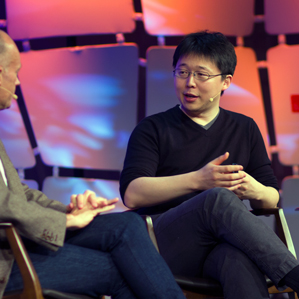EmTech: Risks of Gene-Editing Drugs Need Study, Pioneer Warns
Citing the risk of deadly mistakes, a leading researcher speaking at MIT Technology Review’s EmTech conference on Tuesday said the risks of gene editing need to be better understood before the technology can be used in medical studies.

Feng Zhang, a researcher at MIT, helped invent a powerful new way to alter DNA that he compared in his talk to a “search-and-replace function for the genome.”
Several startups have already sprung up to turn the technology into new kinds of gene-therapy drugs, including CRISPR Therapeutics and Editas Medicine, a biotechnology company that Zhang cofounded last year with venture capitalists who invested $43 million.
These companies hope to correct diseases, like cystic fibrosis, caused by faulty DNA. In other cases, Zhang said, changing a person’s DNA could provide a “protective” effect—for instance, conferring immunity to HIV.
“The concept is very powerful, but to make any correction in the body is very challenging,” he said.
Looming over researchers is the 1999 death of Jesse Gelsinger, a volunteer in an early gene therapy study in Pennsylvania. That failure dealt a huge setback to genetic drugs. Later it was shown that such treatments, even when they work, could sometimes cause cancer by making unwanted changes to a person’s genome.
“One of the early lessons from gene therapy is to go slowly,” said Zhang. “The lesson is that we need to understand a system carefully before putting it into a person.”
Gradually, however, gene therapy has staged a comeback. In 2012, a treatment called Glybera was the first to be approved in Europe. It’s not yet for sale in the U.S., but numerous gene treatments are being tested in patients.
The molecular editing system Zhang helped develop is potentially far more accurate than older gene therapies. Called CRISPR, it was based on the discovery of a mechanism that the bacteria in yogurt use as a kind of primitive immune system to chop up the genes of invading viruses. About two years ago, Zhang and others showed that CRISPR could be used to precisely alter human DNA.
The danger, Zhang said, is that treatments using gene editing could prove toxic, or that scientists could end up changing a person’s DNA in ways they hadn’t intended. What’s more, getting such drugs into the body isn’t easy. That will require using viruses or perhaps liposomes, tiny spheres into which the genetic drug can be packaged.
In other cases, Zhang said, scientists might be able to remove cells from the body, repair their DNA, and then reinject them. Bone marrow cells are a possible candidate for this approach.
“We are working as hard and quick as possible to get the technology into a state where it can be used to treat disease,” he said.
Keep Reading
Most Popular
Large language models can do jaw-dropping things. But nobody knows exactly why.
And that's a problem. Figuring it out is one of the biggest scientific puzzles of our time and a crucial step towards controlling more powerful future models.
The problem with plug-in hybrids? Their drivers.
Plug-in hybrids are often sold as a transition to EVs, but new data from Europe shows we’re still underestimating the emissions they produce.
Google DeepMind’s new generative model makes Super Mario–like games from scratch
Genie learns how to control games by watching hours and hours of video. It could help train next-gen robots too.
How scientists traced a mysterious covid case back to six toilets
When wastewater surveillance turns into a hunt for a single infected individual, the ethics get tricky.
Stay connected
Get the latest updates from
MIT Technology Review
Discover special offers, top stories, upcoming events, and more.